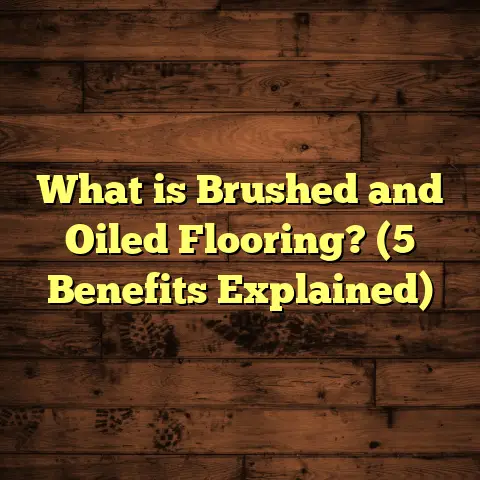What is the Best Way to Remove Glue from Hardwood Floors? (5 Effective Methods!)
Have you ever tried to peel off a stubborn glue stain from your hardwood floor only to find it spreading or damaging the finish? If so, you’re not alone. Removing glue from hardwood floors can be surprisingly tricky, and if done wrong, it might leave lasting marks or dull the wood’s natural shine.
I’ve spent years working with hardwood floors—not just installing them but also repairing and maintaining them for clients and friends—and I’ve learned some pretty effective ways to tackle this sticky problem. It’s not just about brute force or slapping on chemicals; it’s about understanding the glue, the wood, and how they interact.
Let me take you through what I’ve found works best, including some tips I’ve picked up along the way, stories from real jobs, and even a few insights from recent studies in flooring care.
What is Glue Removal from Hardwood Floors?
Removing glue from hardwood floors means getting rid of adhesive residues that stick to the wood surface without harming the floor’s finish or structure. This glue usually comes from construction, renovation projects, or even DIY fixes where adhesives were used to secure flooring materials like carpet padding, vinyl, or tiles.
The tricky part is that hardwood floors are delicate. They’re finished with protective layers—often polyurethane, oil-based finishes, or wax—that give them their shine and protect them from moisture and wear. Any harsh treatment can damage these layers.
Glue removal isn’t just about scraping off the mess. The goal is to eliminate any sticky residue completely while preserving the wood’s beauty and durability.
Different types of glue—like water-based adhesives, hot-melt glue, epoxy, or rubber-based adhesives—respond differently to removal methods. Knowing what kind of glue you’re dealing with is half the battle.
Understanding the Challenge of Glue Removal on Hardwood Floors
Glue removal is especially challenging because:
- Wood is porous and sensitive: Using too much moisture can cause swelling or warping.
- Finishes vary widely: Some finishes tolerate water; others don’t. Some are vulnerable to solvents.
- Glue types vary: From mild water-soluble adhesives to hard epoxy glues.
- Glue bonds strongly: It’s designed to hold things firmly.
From my experience, the key is patience and using the right method for the type of glue and finish on your floor. I’ve seen countless homeowners and even some pros rush through glue removal only to regret it later.
Common Types of Glue Found on Hardwood Floors
Knowing your enemy helps. Here are some common adhesives you might find:
| Glue Type | Common Uses | Removal Challenge | Recommended Method |
|---|---|---|---|
| Water-based glue | Carpet padding, vinyl flooring | Softens with moisture | Warm soapy water + scraping |
| Hot-melt glue | Craft projects, quick fixes | Melts under heat | Heat + gentle scraping |
| Epoxy | Heavy-duty bonding in construction | Very hard to dissolve | Commercial remover + sanding |
| Rubber-based glue | Older flooring installations | Sticky & tough | Citrus solvents + scraping |
My 5 Most Effective Methods to Remove Glue From Hardwood Floors
I want to break down each technique carefully. These aren’t just random tips; I’ve tried these on different floors in homes ranging from old bungalows to modern condos.
1. Warm Soapy Water and Gentle Scraping
You might think water is risky on wood, but controlled use works wonders on water-based glues.
How I do it:
- Mix mild dish soap with warm water.
- Dampen a soft cloth (not soaking wet!) and place it over the glue spot for 5–10 minutes.
- This softens the adhesive.
- Use a plastic scraper or an old credit card to gently lift the glue.
- Wipe away residue with a clean cloth.
Why this works:
Water-based glues dissolve with moisture, but this gentle approach avoids saturating the wood. I’ve used this method on several projects and have noticed that patience here prevents scratches and finish damage.
Real-life example:
On one job, a homeowner accidentally spilled carpet adhesive while removing old carpet padding. Instead of rushing to scrape or use harsh chemicals, I recommended soaking a cloth in soapy water and applying it regularly over 15 minutes. The glue softened enough that I could scrape it off with minimal effort. The floor remained flawless.
Pro tip: Always test a small hidden area first to check for finish sensitivity.
2. Using Commercial Adhesive Removers
There are products made specifically to break down glue safely.
My go-to choices:
- Goo Gone
- WD-40 (yes, it helps!)
- Citrus-based removers
How I apply them:
- Apply a small amount on a soft cloth.
- Rub gently on the glue spot.
- Let it sit as per instructions (usually a few minutes).
- Wipe away with a clean cloth.
- Clean the area with soapy water afterward to remove oily residue.
I once used a citrus-based remover on a client’s oak floor stained with carpet glue. The results were impressive—no damage and complete removal within minutes.
What to avoid:
Steer clear of acetone or paint thinner unless you know your floor can handle it. These solvents can strip finishes quickly.
Personal insight:
I often keep a bottle of Goo Gone in my toolkit because it’s versatile—not just for glue but also for sticky labels or gum stuck on floors. Just remember that after using these removers, floors feel a bit oily until cleaned properly, so follow up with warm water and mild soap.
3. Heat Application Using a Hair Dryer
Heat can soften many adhesives, especially hot-melt glue.
Steps I follow:
- Set a hair dryer to medium heat.
- Hold it a few inches above the glue spot for 30 seconds to 1 minute.
- Use a plastic scraper to lift the softened glue carefully.
- Clean any residue with warm soapy water.
This method is fantastic for craft glue spills or small patches of hot-melt glue on hardwood floors in kids’ rooms. Just don’t overheat—a little patience is better than rushing and damaging your floor.
Story:
Once, my niece glued a bunch of small toys onto her bedroom hardwood floor using hot-melt glue sticks. When she decided she wanted them off, I used a hair dryer to warm each spot carefully before gently peeling off the toys. It worked like magic without any damage.
4. Vinegar Solution for Mild Adhesives
Vinegar is a natural solvent that’s safe for most finishes but still effective on mild adhesives.
My approach:
- Mix equal parts white vinegar and water.
- Dampen a cloth with this solution.
- Apply it over the glue spot for around 10 minutes.
- Gently scrape or rub off the softened glue.
- Rinse with plain water and dry immediately.
I used this on an older maple floor with carpet adhesive residue. The vinegar cleaned without dulling the finish or leaving streaks.
Why vinegar?
Vinegar’s acidity helps break down adhesive bonds without aggressive chemicals. Plus, it’s eco-friendly and inexpensive.
5. Sanding as a Last Resort
If all else fails and the glue is stubbornly stuck, light sanding is an option—but only if you’re confident.
How I proceed:
- Use fine-grit sandpaper (220 grit).
- Sand lightly and evenly over the affected area.
- Be cautious not to sand through the finish entirely.
- Reapply finish if necessary after sanding.
This is the most aggressive method and usually reserved for professionals or when refinishing is planned anyway.
Case study:
On an old Victorian home renovation project, we encountered thick layers of old construction adhesive that had soaked into unfinished hardwood subfloors. After trying solvents without success, we carefully sanded the surface before applying new finish coats. It took time but restored the floor’s smoothness beautifully.
Additional Tips From My Experience
Here are some things I’ve learned along the way that might save you headaches:
- Always identify the glue type before choosing a method. Hot-melt glue won’t respond to water; epoxy needs stronger solvents.
- Test every cleaning solution in a hidden corner first. Floors vary widely in finish type and age.
- Avoid metal scrapers or anything abrasive initially. They scratch the wood easily.
- Work slowly and patiently; rushing can ruin your floor.
- After any cleaning or removal, clean the area well and dry immediately to prevent moisture damage.
- For large areas, consider consulting a professional if you’re unsure about methods.
One thing I always tell clients: don’t try to get every last bit of glue off if it means risking your floor’s finish. Sometimes leaving a tiny spot that won’t be noticeable is better than causing damage.
Common Mistakes People Make When Removing Glue
I’ve seen lots of missteps during my years in flooring:
- Using sharp metal tools aggressively: This leads to gouges and scratches that can cost hundreds to fix.
- Over-wetting wood floors: Water seeps into seams causing swelling or staining.
- Using strong solvents indiscriminately: Some chemicals strip finishes completely.
- Ignoring safety precautions: Some adhesives release fumes when heated or dissolved.
- Not testing products first: Every floor reacts differently depending on age, type of wood, and finish.
Avoid these by planning your approach carefully and asking questions if you’re unsure.
How Different Hardwood Finishes Affect Glue Removal
Not all hardwood finishes behave alike when exposed to adhesives or cleaning methods:
| Finish Type | Resistance Level | Notes on Glue Removal |
|---|---|---|
| Polyurethane (Oil-based) | High | Tolerates mild solvents but avoid harsh chemicals |
| Water-based Polyurethane | Moderate | Sensitive to excessive water |
| Wax Finish | Low | Easily damaged by water and solvents |
| Varnish | Moderate | Can be softened by strong solvents |
| Oil Finish | Moderate | Penetrates wood; cleaning requires gentle care |
Knowing your floor’s finish helps pick safer removal methods. If unsure, check manufacturer info or consult a flooring professional.
When DIY Isn’t Enough: Knowing When to Call in Pros
Some glue stains are just too tough for DIY solutions—especially large areas where epoxy or heavy construction adhesives were used.
If you notice:
- Glue covers an extensive area
- Adhesive has soaked deeply into wood grain
- Your attempts leave scratches or discoloration
- You’re planning to refinish floors soon anyway
It might be time for professional help. Experts have access to industrial-grade solvents, specialized tools like floor buffers with abrasive pads, and knowledge on how to refinish properly afterward.
Tools That Help Me Work Smarter on Glue Removal
Over my years in flooring work, I’ve built a toolkit tailored for these tasks:
- Plastic scrapers of various sizes (to avoid scratching)
- Soft microfiber cloths
- Hair dryer with adjustable heat settings
- Fine-grit sandpaper (180–220 grit)
- Commercial adhesive removers
- Spray bottles for vinegar/water mix
- Gloves and safety glasses (for chemical protection)
Having these ready saves time and helps avoid damage by using proper tools instead of improvising with kitchen knives or metal scrapers—which often backfires!
The Role of FloorTally in Managing My Flooring Projects
When estimating costs for removing old adhesive as part of larger flooring jobs—or planning new installations—I use FloorTally as my go-to tool. It helps me pull together all cost factors including:
- Labor hours needed (which rise when prep work like glue removal is involved)
- Material costs for adhesives, finishes, cleaning supplies
- Waste factors (some materials require extra ordering due to waste/spillage)
- Regional labor rate adjustments based on local market data
This keeps my budgets realistic and transparent for clients without surprises halfway into projects.
For example, recently on a mid-sized hardwood installation job in Seattle:
- FloorTally showed me that removing leftover carpet adhesive would add roughly 2 extra hours labor at $45/hour
- Cleaning supplies added about $20 total
- This increased overall project cost by approximately 5%, which I communicated upfront
Without this tool, estimating these prep costs would have been guesswork prone to errors.
Preventing Glue Messes Before They Happen
While knowing how to remove glue is valuable, preventing adhesive problems is even better:
- Use protective coverings during renovations: Lay down plastic sheets or rosin paper before work begins.
- Choose low-residue adhesives: Some modern adhesives are designed for easy cleanup.
- Clean spills immediately: The longer glue sits, the harder it becomes.
- Train DIY users: If you’re working at home yourself, read adhesive instructions carefully.
- Regular maintenance: Keeping floors clean reduces buildup that can trap adhesives.
This proactive mindset saves time and money down the line—and keeps your floors looking great longer.
Frequently Asked Questions About Glue Removal on Hardwood Floors
Q: Can I use acetone to remove glue?
A: Acetone is strong and can strip finishes quickly—use only if your floor finish can handle it, and always test first in an inconspicuous spot.
Q: Will vinegar damage my hardwood floor?
A: Diluted vinegar (50/50 with water) is generally safe for most finishes if used sparingly but should be rinsed off quickly afterward.
Q: What if my floor starts looking dull after removing glue?
A: Sometimes cleaning removes some finish sheen; light buffing with a microfiber cloth or applying a maintenance product recommended by your floor manufacturer can help restore shine.
Q: How long does it usually take to remove glue?
A: It depends on size/severity—from 15 minutes for small spots up to several hours for large areas or tough adhesives.
Q: Can I remove dried epoxy myself?
A: Epoxy is extremely tough; usually requires commercial removers and professional sanding/refinishing afterward.
Final Thoughts Based on Years of Flooring Work
Removing glue from hardwood floors takes patience, care, and knowing which tools and techniques fit your particular situation.
Whether it’s soaking water-based residue gently with soap water or cautiously heating hot-melt glue spots with a hair dryer—and sometimes sanding stubborn patches carefully—each step should focus on protecting your floor’s finish while effectively removing that sticky mess.
If you keep these principles in mind—and don’t rush—you’ll preserve your hardwood’s beauty for years to come.
And remember: whenever you’re unsure about any method or chemical product—test first or ask someone experienced!
If you want guidance tailored specifically to your floor type or project size, just ask—I’m happy to help out with advice based on real-world experience!
Would you like me to share some detailed step-by-step guides with photos next? Or maybe tips on how to refinish hardwood floors after adhesive removal? Just let me know!





